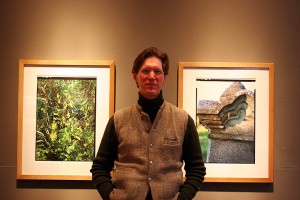Last Monday, students and members of the Grinnell community as well as families from Rochester Township, Iowa, gathered in Faulconer Gallery to listen to Stephen Longmire speak about his project “Life and Death on the Prairie.”
Longmire has been working for the last ten years to compile a collection of photographs and essays about Rochester Cemetery. A number of these photographs are currently hanging in Faulconer Gallery as part of the “Culturing Communities” exhibition.

Longmire is the only artist involved in the exhibition whose work does not specifically relate to Grinnell, but curator Lesley Wright thought the theme of his work introduced an interesting perspective on what it means to be a community.
Rochester Cemetery demonstrates the relationship between people and their surrounding environment well, through the way that the growth of the town has affected the prairie. In Longmire’s book, also titled “Life and Death on the Prairie,” he traces the history of the cemetery from the perspective of the land. As a cemetery, the land has been maintained and to some extent preserved even though it is not protected by conservation services.
Indeed, Longmire emphasizes that in Iowa, the state with the most cultivated land, naturally growing prairie is a rare and beautiful thing. In fact, less than 1% of natural prairie survives today. In the cemetery there are approximately 400 species of plants, the vast majority of which are native. Thus, biologists, bird watchers and other naturalists cherish the rare site.
Although the site is ecologically significant, it is still a functioning cemetery. In Rochester there has been much debate as to how to maintain the land without disrespecting the dead. Some sections of the 13½ acres of the cemetery have been mowed in order to better display the graves—a practice which, some argue, damages the integrity of the prairie. Longmire notes that this debate has been long lived, and ironically, the first year of burial in Rochester Cemetery in 1838, was also the year of the first patent for a lawn mower.
Longmire has difficulty truly depicting the landscape—“to love the prairie in Iowa is to love something you can’t see,” he said. He explains that more than half the biomass of the prairie is underground. However, this is fitting for his project, as it parallels the fact that more than half the population of Rochester is also buried in that ground.
Photography offers Longmire an opportunity to overturn “the great American fiction of wilderness—that people and landscape are separate.” He gathered photographs over a six-year period, which according to him is a full-bloom cycle, and attempted to capture different stories and narratives through the gravestones—some of which were faded and overgrown, while others stood proudly against the green pastures. Thus Longmire’s medium was time just as much as his large-format camera.
His lecture was well-attended and the audience represented the multiple layers that Longmire’s photographs touched upon. His subject matter brought together the two fairly distinct disciplines of biology and art. Some of the Rochester community members who attended returned to to Faulconer later Monday evening to further discuss the town’s relationship with the cemetery.
Although Longmire’s photographs stand alone at the Faulconer Gallery, his lecture contextualized the work within his larger project on the Rochester community. The many different stories and attributes of the site brought the pictures to life and developed an understanding of how man and nature grow together.























































